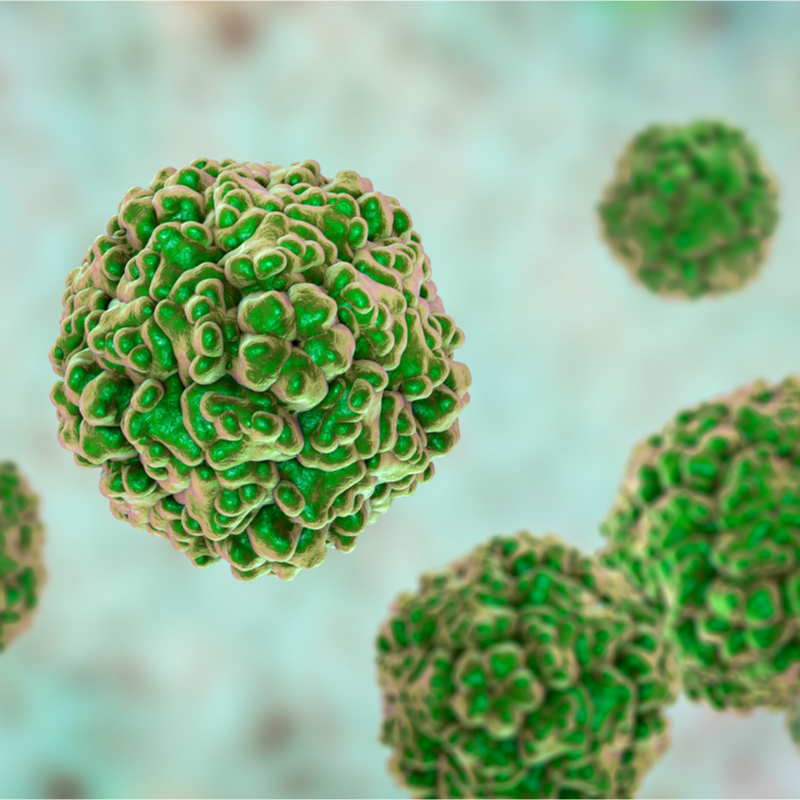
What is the enterovirus?
Enteroviruses are intestinal viruses that belong to the genus of picornaviruses. They replicate in the gastrointestinal tract and can be isolated from the stool or throat . However, replication of the virus can also affect other tissues, muscles or nerves. In most cases, the symptoms after infection are asymptomatic. In the case of an illness with enteroviruses, symptoms can occur as with encephalitis, meningitis, myocarditis, myelitis. Humans can isolate the following enteroviruses : Coxsackieviruses, Echoviruses, Polioviruses as well as 4 other enterovirus types 68-71 In addition to humans, enteroviruses are found in mice, cattle, pigs and even monkeys.
How common is the enterovirus?
The enteroviruses are found all over the world and infection can occur all year round. However, in temperate climates seasonal occurrence is more common in the summer months and autumn months. Depending on the type of virus, the enteroviruses are excreted mainly in the stool or through the throat. Even when an illness has already subsided, enteroviruses can still be detected in the stool for several weeks afterwards. The virus is transmitted via the faecal-oral pathway from person to person or via the stool or saliva. . However, contaminated food, objects or drinking water can also be the cause of infection . The incubation period is usually 3-5 days.
What diseases are caused by enterovirus?
The following diseases are exclusively caused by enteroviruses
- Respiratory infection caused by enterovirus D68: Severe respiratory disease that occurs most often in children and causes symptoms such as coughing and shortness of breath . Not infrequently, the spinal cord is also affected.
- Epidemic Pleurodynia: Epidemic pleurodynia affects the muscles in the chest, causing severe pain, shortness of breath and coughing. This disease is also most common in children.
- Hand-foot-and-mouth disease: You occurs especially in even younger children and is highly contagious. It is most common in the summer and autumn months.
- Herpangina: Infants and toddlers are most often affected by this disease. The small patients complain of sore throat, neck pain, loss of appetite as well as headache. In the course of the disease, greyish bumps form in the throat and mouth.
The
diseases such as encephalitis, aseptic meningitis, myopericarditis
and haemorrhagic conjunctivitis can also be caused by enteroviruses,
but also by other organisms.
How dangerous is enterovirus for newborns?
At birth, it is quite possible that enteroviruses are transmitted from the mother to the child. Normally, a newborn baby suddenly develops a sepsis-like illness a few days after birth. The newborn suffers from fever, has bleeding and is very sleepy. In many cases, the enterovirus damages the tissues and organs, unfortunately resulting in death from multi-organ failure.
What are the symptoms of enterovirus?
Since the body's own defences stop many of the enterovirus infections, in many cases there are no or only minor symptoms. In many people who are affected, the enterovirus makes itself felt with symptoms and discomfort in the upper respiratory tract. These are very similar to those of a cold. In only a few patients is viral pneumonia the result.
However, if the enteroviruses cannot be killed with the help of the immune response, they can spread unhindered through the blood throughout the body and cause fever, sore throat, headache, as well as vomiting and diarrhoea. Because of these symptoms, there is often talk of the so-called summer flu , although this illness has nothing to do with flu.
Certain enterovirus strains can also cause a rash or sores in the mouth. This type of illness is actually the most common consequence of infection with enteroviruses. In the rarest cases, a specific organ is attacked by the enterovirus after this stage. The severity of the disease with the enterovirus then depends on which organ is affected.
How is enterovirus diagnosed?
If a case of illness is only mild, specific detection of the enterovirus is not necessary. If the disease is more severe, or occurs more frequently in community facilities such as schools or kindergartens, the appropriate material for detecting the viruses can be sent to a special laboratory.
- Material submission: Enteroviruses can be detected in throat rinsing water, throat swabs, stool and cerebrospinal fluid, depending on clinical symptoms. Enteroviruses are most frequently found in stool.
- PCR test: If there is an acute illness, the diagnosis is mainly carried out by means of a pathogen detection using a PCR test.
- Virus cultivation: In addition to the PCR test, the virus is cultivated in different cell cultures and then serotyped. With the help of this serotyping, the disease can be clarified epidemiologically in the event of a frequent occurrence.
How is enterovirus treated?
In the first line of treatment is symptomatic with painkillers and antipyretics. If the course of the disease is severe, gamma-globulin preparations are used. If there is a secondary infection with bacteria, treatment is with an antibiotic. So far, antiviral preparations and substances are still being tested . Studies have shown that interferon is suitable for cardiomyopathies.
How can enterovirus be prevented?
The most important are hygiene measures such as hand washing. This can efficiently prevent the spread of the viruses. A pregnant woman should avoid contact with people who are suspected of being infected with enterovirus. To date, there is no non-polio enterovirus vaccination available in Germany .
